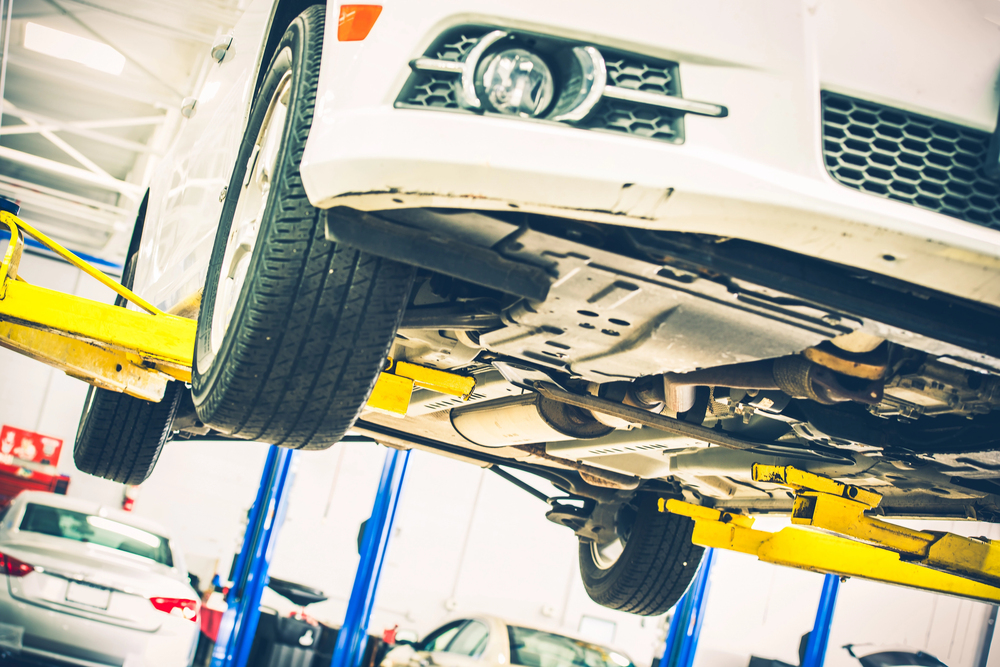


Recently, ISO released a multi-state forms revision for the ISO Businessowners Policy (BOP), a comprehensive package designed for small and midsize Main Street garage operations. The multi-state ISO BOP combines property and liability coverage under the Businessowners Coverage Form (BP 00 03). With optional coverage and exclusionary endorsements, underwriters can customize the policy to address the specific risks of eligible businesses. This major overhaul of the BOP program is effective in most states on July 1, 2025.
Since most claims in auto service risks arise from slip and falls, ISO removed eligibility of auto service risks from garage coverage. Given this, these risks were more appropriately written under the ISO commercial general liability program.
Now, after a recent multistate ISO filing, automobile service operations are eligible for businessowners coverage. Yes, you read that right. Garage operations that carriers previously wrote under a garage form can now be included on a BOP.
Which Garage Operations Are Eligible on the ISO BOP?
Most of the risks historically covered under the ISO Garage Liability form (CA 00 05) prior to 2013 can now qualify for coverage under the BOP, assuming they meet the general qualifications for BOP coverage.
In general, risks may not exceed 35,000 square feet in total floor area or exceed $6 million in annual gross sales at each location for coverage under the ISO BOP program. When you think about typical standalone garage risks, many shops that service cars and trucks will qualify for BOP coverage. However, your carriers may roll out slightly different eligibility guidelines, so work with your carrier marketing representatives to determine the eligibility requirements.
Here are the eligible businesses engaged in servicing cars and trucks that fall within the new auto service risk classifications.
There is some overlap in the classifications, which requires further refinement. Per the ISO manual rules, the Auto Body Shop class is specifically for risks specializing in body work on motor vehicles of all types, including vehicle wrapping and truck bedliner installation. ISO describes eligibility for Repair Shop—Major as risks engaged in major auto repair work, including body work, painting, dent repair, major engine repair and transmission repair.
ISO describes Repair Shop—Minor as risks engaged in minor auto repair work, including air conditioning, alignment, battery, brake, electrical, glass, ignition, muffler, radiator and spray-on bed liner repair. ISO does not describe what differentiates “major” versus “minor” engine repair work. This would be an underwriting determination.
Additionally, ISO describes Quick Lube Shops as applying only to those risks providing services for quick lubrication, oil change and maintenance of fluids or air levels.
With the expanded eligible class list and the general BOP eligibility, most auto service risks fall within BOP coverage. However, auto dealers do not qualify for BOP coverage and are appropriately covered under the Auto Dealer Coverage Form (CA 0025).
ISO BOP: Endorsements and Exclusions
Since the withdrawal of the Garage Coverage Form (CA 00 05) in 2013, auto service businesses were generally covered by a combination of the Commercial General Liability (CG 00 01) and Business Auto (CA 00 01) forms with some specific endorsements attached, such as Garagekeepers Coverage (CA 99 37). Similarly, the BOP program will now utilize some auto service-specific endorsements to adapt the BOP to meet the needs of eligible automobile service risks.
Unlike other businesses that qualify for BOP coverage, auto service risks have exposure to losses arising from non-owned autos. There may be a need to test drive a customer’s car or an employee may make the occasional run to a part shop. Hence, there is a need to modify the business liability section of the BOP. This endorsement is used with the Auto Service Risks—Supplemental Schedule (BP DS 09).
The Auto Service Risk Endorsement (BP 15 98) accomplishes this by modifying the aircraft, auto and watercraft exclusion by carving out an exception for non-owned autos. This exception identifies cars of employees, partners, officers and their families when used in the insured’s business or the insured’s personal affairs.
Additionally, it identifies the customer’s auto while the insured is attending, servicing, repairing, operating or storing the “customer’s auto” at or temporarily away from premises shown in the schedule. Of course, coverage does not apply to any racing events.
The endorsement also narrows the “your product exclusion.” The business liability section of the BOP excludes property damage to the insured’s product and defines the insured’s product, in part, as any goods or products, other than real property, manufactured, sold, handled, distributed or disposed of by the insured. Thus, the endorsement excludes any property damage to the actual work the shop completes.
However, the Auto Service Risks Endorsement narrows the exclusion to not apply if the property damage is caused by a defect that existed in the insured’s product or any part of the insured’s product when it was transferred to another and the defect was not the result of the insured’s work.
The property section of the Auto Service Risks Endorsement provides some coverage enhancements beyond the BOP. They are:
Additionally, the Auto Service Risks Endorsement provides some additional coverage not provided under the BOP. Those are:
The Auto Service Risk Endorsement also offers an optional coverage titled “Loss or Damage to Customer’s Autos and Other Customer’s Property (Legal Liability Coverage).” Selecting this coverage on the Auto Service Risks—Supplemental Schedule (BP DS 09) would allow this legal liability coverage.
The insuring agreement specifies:
We will pay all sums you legally must pay as damages for direct physical loss of or damage (including any resulting loss of use) to ‘customer’s autos’ or other property of customers left in your care while you are attending, servicing, repairing, operating, or storing the ‘customer’s auto’ at or temporarily away from a premises shown in the Schedule. Such loss or damage must be caused by or result from a Covered Cause of Loss.
It appears that the BOP program seeks to provide what is traditionally called garagekeepers coverage under the property portion of the BOP. The coverage tracks with legal liability language that traditional garagekeepers coverage provides but says the loss must arise out of covered perils. As the BOP is an open peril coverage form, any coverage would be subject to what is specifically excluded.
Initially, the insuring agreement identifies that the policy provides coverage on a legal liability basis. However, the insured can opt to choose—probably at a higher premium—a direct primary coverage option, changing coverage from legal liability to coverage without regard to the insured’s legal liability for loss. Choosing the Auto Service Risks—Supplemental Schedule (BP DS 09) option would provide coverage.
ISO also provides two endorsements that are intended for use by risks that still qualify for businessowners coverage but do not fall within the classifications listed. For example, such as when the auto shop has vehicles left in its care. Similar to BP 15 98, both only cover the insured’s legal liability for a covered cause of loss.
The Loss or Damage to Invitees’ Autos (Legal Liability Coverage)—Scheduled Premises Endorsement (BP 15 96) provides a single limit per event, whether it be a fire or a collision, between two customers’ autos.
The endorsement includes a deductible that applies for each vehicle. Other than collision (comprehensive) claims are also subject to a maximum deductible for a single event. For example, in a fire there could be multiple per vehicle deductibles subject to an event maximum. If the endorsement listed a $250 per vehicle deductible and $1,000 per event deductible, the insured would be responsible for the first $250 for each car subject to a maximum of $1,000 for the fire.
The big restriction is that the endorsement does not provide any coverage away from the designated premises. If a customer’s vehicle is driven off the premises for a test drive, coverage for damage to those vehicles ceases the moment the car leaves the premises. From a pragmatic perspective, this endorsement may meet the needs of service operations where customer autos are never driven off the premises, such as quick lube shops, inspection services and car washes. However, full-service shops should avoid this endorsement if vehicles are taken off the premises—for example, for body shop service or other services.
With the Loss or Damage to Invitees Autos (Legal Liability Coverage)—Care Custody, or Control Endorsement (BP 15 97), limits and deductibles follow the same methodology. However, coverage applies while the vehicle is in the shop’s care, custody or control while attending or operating the autos at or temporarily away from the premises.
This provides coverage for customer autos during test drives. That makes this endorsement significantly broader than the Loss or Damage to Invitees’ Autos (Legal Liability Coverage)—Scheduled Premises Endorsement and appropriate when there are off-premises exposures.
Further, the Auto Service Risks—Canine Exclusion (BP 15 99) excludes “bodily injury” or “property damage” arising out of direct physical contact with a canine that is owned by or in the care, custody or control of an insured.
A Word Of Caution About the ISO BOP
It is a positive that auto service risks will now be eligible for BOP coverage. The breadth and simplicity of the BOP makes this attractive to auto service risks. However, we caution that any auto services risk that has more than a non-owned auto exposure should obtain coverage for their business auto exposures.
It is also important to understand that legal liability for a customer’s vehicles left in the insured’s care is only provided for legal liability that pertains to a covered cause of loss. This is a significant reduction in coverage from garagekeepers coverage under ISO’s commercial auto, which does not restrict the insured’s legal liability to covered causes of loss and should be carefully considered.
Lastly, we have not seen the pricing of the BOP coverage for auto service risks. Therefore, it is still advisable that agents compare pricing between the BOP auto service risk options and the traditional approach with a combination of the CGL and the business auto forms. Along the same lines, it is important for agents to work with their insureds to uncover areas of risk and seek appropriate methods to cover those risks.
The Big “I” Virtual University is the smarter way to build your knowledge base. Access online education resources and more than 18,000 pages to help you find the answers to tough insurance questions.